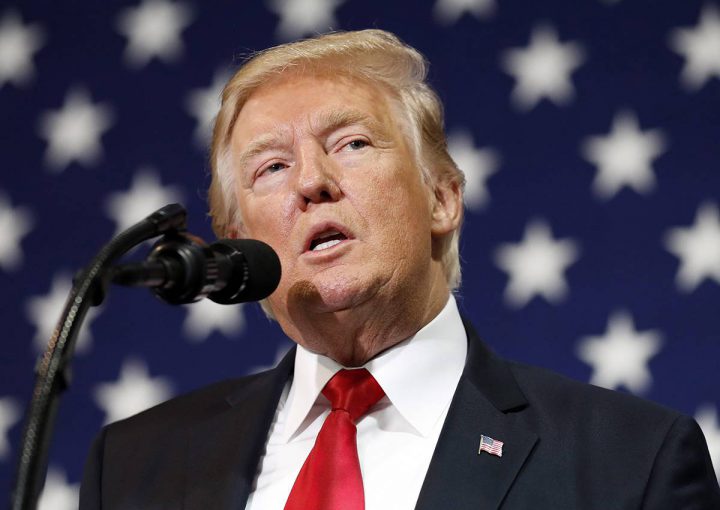WASHINGTON — When in doubt, President Donald Trump has a ready-made response to any questions: “We’ll see.”

On Wednesday, Trump delivered his go-to line repeatedly. Asked if he would tie debt ceiling legislation to Harvey relief: “We’ll see.” On his plans for an increasingly aggressive North Korea: “We’ll see.” And on efforts to work with the Chinese president: “We’ll see how that works out.”
READ MORE: Trump offers reassurance to ‘Dreamers’ on heels of debt ceiling deal
Trump relies heavily on “we’ll see” in the White House, when parrying questions about national security, policy deliberations and personnel. For the onetime real estate tycoon and businessman who often campaigned as a master deal-maker, the vague phrase is a multitasking placeholder that helps him stall for time, keep his options open and build suspense.
“It goes to the overall negotiating strategy of being unpredictable and noncommittal. Everyone stays guessing,” said Sam Nunberg, a former campaign aide. “He’s always used that.”
Trump has deployed the line throughout the year, as the administration sought to push back against North Korea’s development of its nuclear and missile program, as he weighed exiting the Paris climate deal and as he spoke about efforts to renegotiate NAFTA.
WATCH: Trump hails ‘very friendly’ bipartisan meeting as turning point for GOP, Dems

A well placed “we’ll see” also proved a helpful way for Trump to put an aide on ice during a year that has been replete with staff shake-ups. During a contentious mid-August news conference in Trump Tower, the president was asked if he still had confidence in Steve Bannon, then a senior strategist. “He’s a good person. He actually gets very unfair press in that regard. But we’ll see what happens with Mr. Bannon,” Trump said. Three days later, Bannon was out.
At times, “we’ll see” can prompt anxiety. On Sunday, Trump exited an Episcopalian church near the White House and was asked by reporters if he would attack North Korea. “We’ll see,” he said, prompting a flurry of questions internationally about U.S. plans for the Korean peninsula.
FACT CHECK: What the Trump administration said about DACA
Trump has used the expression to build suspense, as he did in February when deciding who should replace fired national security adviser Michael Flynn. Trump said: “I’ve been thinking about someone for the last three or four days, we’ll see what happens.” The president ultimately chose H.R. McMaster.
At other moments, it may simply have helped him stall. Back in January, in advance of his first conversation with Russian President Vladimir Putin, Trump was noncommittal about whether he was considering lifting economic penalties, telling reporters. “We’ll see what happens.” The sanctions remain in place, for now.
Michael D’Antonio, a Trump biographer, said the expression provides a way for the president to inject an element of suspense even when he might not have a decisive option at the time.
“Saying ‘we’ll see’ is almost a way of suggesting that there’s something in the offing, he knows what it is and all will be revealed in time,” D’Antonio said.
Michael Caputo, a former adviser to Trump’s campaign, said the use of the phrase may also be an indicator that the president has decided to be more cagey in his dealings with Republicans. He noted Trump’s use of the line several times on Wednesday, the same day he reached agreement with congressional Democrats to keep the government running and raise the nation’s debt limit.
“Why would the president show the Republican leadership of the House his cards? They’ve been playing their cards against him for months. This ‘we’ll see’ is a sign that the Republicans better get their house in order,” Caputo said.
WATCH: Trump describes Hurricane Irma as ‘not good’

Of course, Trump has been throwing about “we’ll see” since long before he entered the White House.
During the campaign, he used it to express skepticism about how he would be treated at the first presidential debate. Speaking on “Fox and Friends,” he said the debates are “a very unfair system, so we’ll see what happens.”
In 2004, Trump – then starring on the reality show “The Apprentice” – said television networks wanted to film his wedding to the former Melania Knauss, now the first lady. Trump said two networks wanted to hear him say, “I do,” instead of “You’re fired!”
“Everybody wants that to happen except for me and Melania,” said Trump. “We’ll see.”
In the end, the lavish wedding at Trump’s Florida estate, Mar-a-Lago, was not televised.



Comments